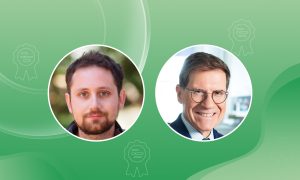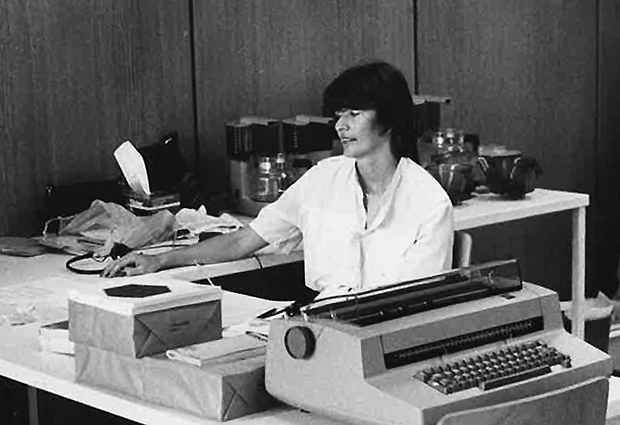
Read the latest Issue
During the past 40 years, Nelly van der Jagt has watched the Laboratory grow from scratch. This month employee number 47 retires, leaving behind a legacy that intricately linked her life with EMBL.

“My attention was caught by a tiny advert in the local newspaper saying that EMBL was looking for an office clerk – I didn’t know what EMBL was, but I was intrigued and sent in an application,” explains Nelly van der Jagt, who is retiring from her role as Unit Administrator for the Structural and Computational Biology Unit at EMBL Heidelberg. Thanks to that letter, Nelly became one of just a handful of founding staff members, witnessing 40 years-worth of EMBL evolution, with a front row seat to several milestones that made the Laboratory what it is today.
The construction of EMBL’s headquarters began in 1975; so initial recruitment interviews took place at the German Cancer Research Centre (DKFZ), located in downtown Heidelberg. “The Laboratory’s entire administration was housed in just four offices at DKFZ, before moving to container rooms at the Max Planck Institute for Nuclear Physics, and later to makeshift offices where the Kinderhaus now stands,” she recalls. Nelly began her EMBL life working for the council and finance committee secretariat – and initially international delegates were meeting in another location in the city centre. “Staff had to travel often between different sites – I made many trips up and down the hill – they were exciting and different times!” It was not until 1978 that the main building was inaugurated, while the EMBL Advanced Training Centre opened in 2010.
Until 1982, Nelly was preparing the many documents necessary for council and finance meetings in three languages, equipped only with her trusty typewriter and copy machine – however, as robust as they may be, typewriters do not have spell checks and require Tipp-Ex to delete mistakes. “I was the first person in EMBL’s administration to have a computer, around 1984,” she recalls. “It was the first Macintosh – small and very expensive – and it made a massive difference to the work I was doing. I recall the amazed look on the faces of colleagues when I showed them how to use it.” By the time the World Wide Web emerged in 1992, Nelly was working as programme secretary for the Structural and Computational Biology Unit. “Letters became a thing of the past, fax-machines disappeared, and emails kicked in,” she explains.
I was the first person in EMBL’s administration to have a computer, around 1984.
In 1983, Nelly began working for the EMBL Director General’s office and soon found herself juggling four roles: personal assistant to the DG and the Administrative Director, as well as organising practical courses for scientists and the fledgling EMBL International PhD Programme (together with John Tooze, then Executive Secretary of EMBO). “As a new research institution EMBL needed to attract new talents, and ensure they felt welcome,” explains Nelly. “It worked so well that the PhD and courses programmes soon grew beyond the scope of a single person. Lennart Philippson, then DG of EMBL, came into my office and asked if I would be angry if some of the responsibilities were shared with new colleagues – of course I wasn’t, and it has been amazing to see the growth of two central parts of the Laboratory since.”

Back in the days when Nelly was given staff number 47, all employees could fit into a single room. “We had a lot of get-togethers: birthdays, carnivals, national celebrations, and so on,” she smiles. “It was a very small and tightly-linked community – pleasant, motivating and inspiring. This community-feeling still exists today, although the number of employees has grown to the extent where it is no longer possible to know everybody on campus.”
It was a very small and tightly-linked community – pleasant, motivating and inspiring.
Just one example of her and colleagues going the extra mile came when welcoming visits to an EMBO conference. “A couple arrived at the registration desk with a child they needed taking care of for the day – we didn’t have the Kinderhaus at that time, so I phoned Konrad Müller, then Head of Personnel, who promptly drove the child to the European school in Karlsruhe,” says Nelly. “After he came back, the boy spent the rest of the day painting in my office until his parents picked him up.” Later the Kinderhaus was set up, which both of Nelly’s daughters attended.
She explains that one of the best things about being in a place as international as EMBL is that it encourages open-mindedness. “There is no such thing as ‘normal’ when the norm can differ so much between nationalities and cultures – it is stimulating, challenging and can quickly become a way of life,” says Nelly, who is Dutch, has a Spanish husband, and lives in Germany. “Our daughters grew up speaking three languages at home and learning another three along the way,” she says. “The advantages of being integrated into such an international environment are enormous: it shaped their entire lives in a very positive way.”
In her role, Nelly had to organise trips for scientists travelling all over the globe. However, until recently her own feet stayed firmly on the ground, hindered by her fear of planes….but a few years ago she took part in a special training organised by German aviation giant Lufthansa. Now, with the world at her feet and time on her hands, we wish her retirement will be every bit as fulfilling as her time working at EMBL.
Looking for past print editions of EMBLetc.? Browse our archive, going back 20 years.
EMBLetc. archive